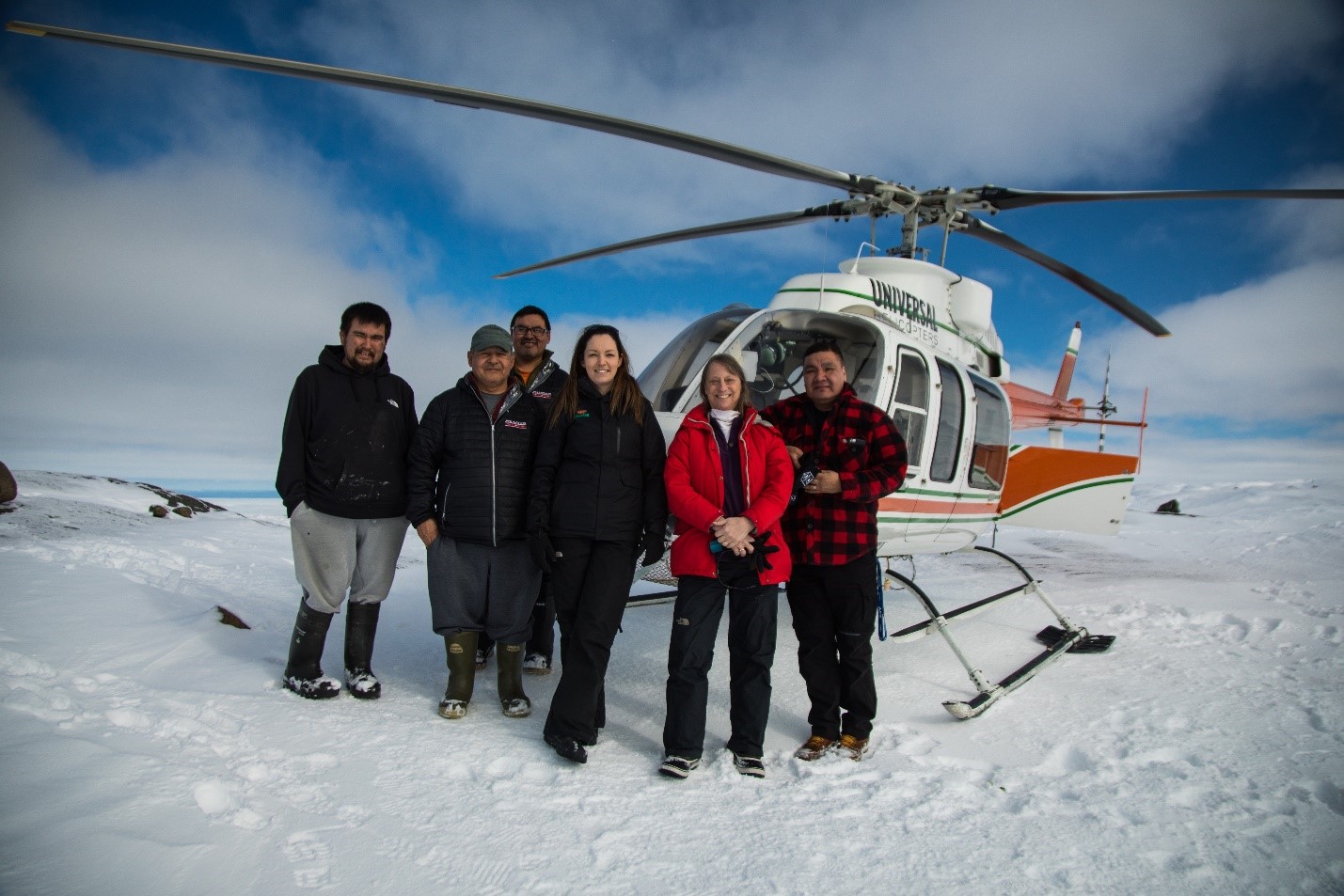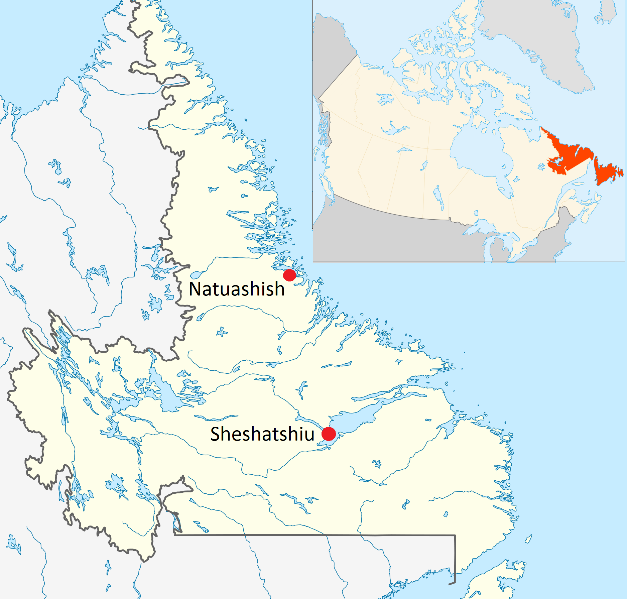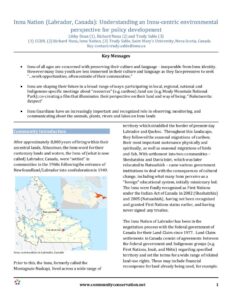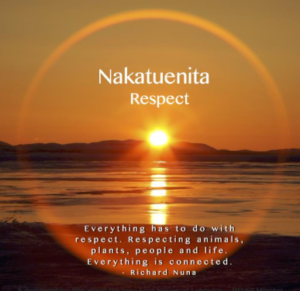
14 Sep Innu Nation, Labrador, Canada
Key Message
- Innu of all ages are concerned with preserving their culture and language – inseparable from Innu identity. However many Innu youth are less immersed in their culture and language as they face pressures to seek “…work opportunities, often outside of their communities.”
- Innu are shaping their future in a broad range of ways: participating in local, regional, national and Indigenous-specific meetings about “resources” (e.g. caribou); land use (e.g. Mealy Mountain National Park); co-creating a film that illuminates their perspective on their land and way of being: “Nakatuenita: Respect”
- Innu Guardians have an increasingly important and recognized role in observing, monitoring, and communicating about the animals, plants, rivers and lakes on Innu lands
(1) Libby Dean, (2) Richard Nuna and (3) Trudy Sable
(1) CCRN, (2) Richard Nuna, Innu Nation, (3) Trudy Sable, Saint Mary’s University, Nova Scotia, Canada
Key contact: trudy.sable@smu.ca
Community Introduction
After approximately 8,000 years of living within their ancestral lands, Nitassinan, the Innu word for their customary lands and waters, the Innu of (what is now called) Labrador, Canada, were “settled” in communities in the 1960s following the entrance of Newfoundland/Labrador into confederation in 1949.
Prior to this, the Innu, formerly called the Montagnais-Naskapi, lived across a wide range of territory which straddled the border of present-day Labrador and Quebec. Throughout this landscape, they followed the seasonal migrations of caribou, their most important sustenance physically and spiritually, as well as seasonal migrations of birds and fish. With settlement into two communities –Sheshatshiu and Davis Inlet, which was later relocated to Natuashish – came various government institutions to deal with the consequences of cultural change, including what many Innu perceive as a “foreign” educational system, initially missionary led. The Innu were finally recognized as First Nations under the Indian Act of Canada in 2002 (Sheshatshiu) and 2005 (Natuashish), having not been recognized and granted First Nations status earlier, and having never signed any treaties.

The Innu Nation of Labrador has been in the negotiation process with the federal government of Canada for their Land Claim since 1977. Land Claim settlements in Canada consist of agreements between the federal government and Indigenous groups (e.g. First Nations, Inuit, and Métis) regarding specified territory and set the terms for a wide range of related land-use rights. These may include financial recompense for land already being used, for example. One of the most valued aspects of a Land Claim agreement for Indigenous groups is having an undisputed “voice” about what happens on their land, as well as reaping benefits from activities that occur on that land (e.g. financial benefit from resource development or tourism). The impact of many of these activities have occurred for centuries – with huge financial gain for outside entities – without recompense to the Innu and other Indigenous communities who live in this region. A similar history exists around the entire globe.
![Filming Nakatuenita [photo: Trudy Sable] Filming Nakatuenita [photo: Trudy Sable]](https://www.communityconservation.net/wp-content/uploads/2020/09/filming.jpg)
Sheshatshiu and Natuashish are considered to be “reserves” under the Indian Act. Sheshatshiu is a thirty-minute drive from Goose Bay, Labrador, which grew around the creation of a NATO air force base during World War II. Natuashish is only accessible by plane and snowmobile, or by boat when the ice breaks up. The land of the Innu includes tundra and boreal forest, which they use for cultural and livelihood purposes, as well as spiritual sustenance. Many of the Innu, particularly the older generations and Tshishennuat (Elders) spend long periods of time at traditional camping areas in nutshimit, the country, where they live directly off the land from hunting animals, fishing, and gathering various berries and medicines. With the arrival of development projects, an increasing number of Innu find work in the forestry and fisheries industries and, more recently, the Muskrat Falls hydro-electric development project. Some of this work is specifically stipulated to be “for Innu” in Income Benefit Agreements (IBAs) negotiated between the Innu and developers, however the work usually has requirements that do not fit with Innu customs, such as living on the land periodically. It is unknown what work opportunities there will be for Innu in the newly created Mealy Mountains National Park, adjacent to and encompassing their customary land.
Being Innu
The Innu have experienced rapid change since settlement in communities in the 1960s. Lifestyles have changed dramatically since then, and many of the social plagues of colonization have accompanied the Innu communities. Many of the Innu, particularly the Tshishennuat (Elders), are concerned about the youth and the passing on of their culture. Many younger Innu are speaking English instead of their language, Innu Aimun. Fewer youth live off the land as the Tshishennuat once had, and many have never been “in the bush” at all. Tshishennuat grew up living off the land and speaking only Innu Aimun. The Innu Aimun word, nutshimit encompasses all aspects of living on the land.
![Innu Camp [photo: Trudy Sable] Innu Camp [photo: Trudy Sable]](https://www.communityconservation.net/wp-content/uploads/2020/09/innu-camp-2.jpg)
Innu Elders are concerned that their language and knowledge of the land will be lost. Many Elders and other community members have long emphasized the importance of being connected to the land and experiencing the intergenerational learning by living together in nutshimit as integral to remaining rooted in the inherent environmental, social and cultural values, as well as critical life skills that are part of what it means to be Innu. Language is considered inseparable from Innu identity and the conservation of the land. The language holds the knowledge of the land and its many features.
The time spent by Innu camping and hunting within their traditional camping areas has become dramatically reduced, and the youth are increasingly speaking English, a foreign language. The Elders talked about the land as their life, as their source of food and medicine, and who they are as Innu (Sable et. al. 2006). Many say they get sick when they are not able to go on the land. A select group of Tshishennuat participate as advisors to the Land Claim process, but as many of the Tshishennuat are dying, much of the language of the land goes with them.
The middle-aged generation grew up spending time on the land and following their traditional practices and beliefs, but also living in the communities and attending mostly the lower grades (up to Grade 8) of Western education. Though still retaining their language and holding much of the knowledge of the land, many are also victims of the diseases of colonization – diabetes, cancer, heart problems, alcoholism, etc.
The youth are a rapidly increasing demographic in Innu communities, as is true in other Indigenous groups. Youth are generally spending less time on the land than their parents did, and some of them have never been on nutshimit. However, there is quite a bit of variability between the two communities of Sheshatshiu and Natuashish, Natuashish being more remote. More and more of the Innu youth are attending their community schools, while some opt to attend the provincial schools. Gradually, the rate of high school graduation is increasing, and a number of graduates are finding employment within their community or with new development projects. Though many still speak Innu Aimun as their first language, the younger children are learning English as their first language, while re-learning Innu Aimun at their school where efforts are being made to develop culturally relevant content.
![Youth research participants, Sheshatshiu [photo: Libby Dean] Youth research participants, Sheshatshiu [photo: Libby Dean]](https://www.communityconservation.net/wp-content/uploads/2020/09/youth-research.png)
It is worth noting that while this article is mostly about “conservation and livelihoods”, Innu communities are simultaneously working on other pressing issues related to health, education, culture, governance, transportation and infrastructure, to name a few that require a huge amount of time, resources and effort, at times by the same small pool of people.
Innu Conservation and Livelihoods – Challenges & Opportunities
The Innu Nation is currently in the process of Land Claim settlements, an arduous, multi-year process. This includes developing a “land use” plan for designating different levels of land use and management practices for both the tundra and boreal forest environments they inhabit, e.g., those for cultural use, those for economic development, those for recreation, etc., once the land claims are settled. The Innu are, and have been for years, involved in numerous negotiations concerning resource development projects within Nitassinan, as well as with provincial and federal government agencies to deal with multiple levels of land-use, e.g. forestry, fishery, caribou and migratory bird management.
Specific to the resource development projects, such as the Voisey’s Bay nickel mine and the current Muskrat Falls hydro-electric development project, the Innu have negotiated Economic Impact Benefit Agreements ensuring training and jobs, as part of their settlement agreements with the corporations. These agreements can bring employment to the communities and provide training and jobs with attractive salaries (e.g. heavy equipment operation, catering, maintenance, environmental monitoring). Economic incentives are part of a larger debate around the benefits of relatively short-term and commonly (but not exclusively) lower skill / lower salary jobs, versus long-term sustainable development and conservation of ancestral lands. As with any community experiencing the possibility of resource development in their homeland, not all Innu share the same views on how to move forward – and often the discussion comes down to a development vs. tradition polarity which neither acknowledges the full complexity of the issues nor suggests a clear path forward.
Community Initiatives
Innu continue their efforts to protect their ancestral lands and way of life, as well as to balance their livelihood needs and engage with resource development in their homelands. Currently, the Innu are continuing to bring the issue of caribou populations and harvest restrictions to the fore. There have been decades of discussions already, and recently there have been some strides in helping non-Innu start to understand that the Innu relationship with atik (caribou) is much more than numbers. Innu are in the process of developing their own environmental policy, an effort the Community Conservation Research Network supported.
With limited resources, Innu are working at many levels to gain traction on the issues that are most urgently arising in their communities. These are some of the environmental and conservation initiatives Innu are currently working on:
- Developing Innu-based environmental standards and land management regulations that are based on Innu cultural values
- Communicating with the people Innu interact with—and the Innu—so they understand why the Innu need Innu-based policies, and what these policies are and mean
- Helping the Innu understand the overall relationship between the Innu and the provincial and federal government – and what the impact is of policies regarding Innu management of their own land and Innu policies for their own land
- Understanding what Innu want to see on the ground once the land claims are settled
Research, Capacity-Building and Consultation
The Innu have a decades-long relationship with researchers from universities, including Dr. Trudy Sable from Saint Mary’s University (SMU) in Halifax, Nova Scotia, Canada, which partners with the Innu Nation Environment Department. The Innu also partner with NGOs, researchers and consultants who continue to work closely with them, as they traverse the many layers of negotiations and development planning – and getting their voice heard more widely. The Innu have a Memorandum of Understanding (MOU) with Saint Mary’s University, which demonstrates mutual benefit and has resulted in the Innu Nation’s participation within the Community Conservation Research Network. With support from CCRN, the Innu did a number of things to support the development of their environmental policy. As part of this work, the Innu and invited researchers conducted interviews and focus groups with Sheshatshiu community members (including youth and elders) to better understand what conservation means to them and its connection to restoring, protecting and maintaining their traditional lifestyle.
In addition, a member of the Innu Nation environment department staff, Helen Andrew, came to Saint Mary’s University for three weeks to gain practical skills training (e.g. report writing, project management, and negotiation skills) and attend classes, lectures and public talks on environmental issues and policy, resulting in two certificates from the university.
![Helen Andrew, Innu Researcher, receiving certificates for Saint Mary’s University [photo courtesy of Libby Dean] Helen Andrew, Innu Researcher, receiving certificates for Saint Mary’s University [photo courtesy of Libby Dean]](https://www.communityconservation.net/wp-content/uploads/2020/09/smu-1-1.jpg)
In Sheshatshiu, a multi-day workshop developed and coordinated by Richard Nuna and Trudy Sable was held to discuss the development of environmental policy based on the views of the Innu. It was held at the school and included Innu elders, guardians, staff of the environment department from Natuashish and Sheshatshiu, the Saint Mary’s University project lead, one SMU researcher, the CCRN director, Environment Canada regional staff, and some members of the community. In order to gain a greater understanding of the environmental issues in the region, of the implementation and development process of an environmental policy, on the impacts and benefits of an environmental policy, and on how the Innu can benefit from and be involved in the policy process, Innu representatives, along with CCRN researchers, met with provincial and federal governments. Though the Newfoundland provincial government plays a larger role in the various Innu Land Claims processes than the Federal government, Environment Canada does play a significant role. In meeting the Senior Aboriginal Consultant to Environment Canada, a number of useful points were raised in how the Innu could negotiate land claims up front that would benefit their needs once claims are settled. Meetings such as this are places where Innu are increasingly participating as partners – rather than recipients of one-way information – in discussing the future of their land, and the policies that relate to it.
Practical Outcomes
Understanding, Developing and Participating in Policy
Innu are becoming stronger participants in the decisions which affect their future – especially in regard to conservation and livelihoods. The Innu Guardians are gaining skills and take a “stronger place at the table” now in discussions on caribou, land use, and more. Innu have a more respected “voice” in these discussions. In 2018, the film, ‘Nakatuenita: Respect’ was screened in Halifax, Nova Scotia with the Grand Chief, Gregory Rich and three Innu Guardians present. The film was a co-production between the Innu Nation’s environment director, Richard Nuna, and Dr. Trudy Sable of SMU/CCRN. The film, approximately one hour long, includes unique footage of Innu ancestral lands and features in-depth interviews with many community members to document and communicate the connection they have with the land – and the interconnected environmental, social and cultural values.
![Nakatuenita film crew on the land [photo: Kent Martin] Nakatuenita film crew on the land [photo: Kent Martin]](https://www.communityconservation.net/wp-content/uploads/2020/09/film-crew.jpg)
Living and Communicating About Nakatuenita
As Innu travel their time-worn paths they are simultaneously creating new ways of being in the world, and of showing that Nakatuenita (Respect), is an inextricable part of being Innu. People who are working with Innu and who are doing anything on or in Innu ancestral lands and waters are expected to meet them along these physical and metaphorical pathways and to travel, listen and learn side-by-side with respect. The Innu are developing the means to demand this respect. There is no other way forward into the unknown future.
References
Ashini, Daniel. “David Confronts Goliath: the Innu of Ungava versus the NATO Alliance”. In Drumbeat: Anger and Renewal in Indian Country. Boyce Richardson, ed. Summerhill Press, The Assembly of First Nations.
Loring, Stephen: Princes and Princesses of ragged fame: Innu archaeology and ethnohistory in Labrador. https://scholarworks.umass.edu/dissertations/AAI9233093/
Nakatuenita: Respect. A film produced by Trudy Sable and Richard Nuna. Director, Cinematographer, Editor: Kent Martin. Funded through the CCRN with additional support from the Innu Nation of Labrador, 2019
Pepamuteiati Nitassinat Website: innuplaces.ca
Sable, Trudy with Geoff Howell, Dave Wilson, and Peter Penashue. “The Ashkui Project: Linking Western Science and Innu Environmental Knowledge.” Local Science vs. Global Science: Approaches to Indigenous Knowledge in International Development, ed. by Paul Sillitoe, Ph.D. New York: Berghahn Books (Oxford). August 2006.
Trant, Andrew, John D. Jacobs, Trudy Sable. “Teaching and learning about climate change with Innu Environmental Guardians.” In, Polar Geography, Vol. 35, Issue 3-4, 2012
Acknowledgements
- Gratitude to Nitassinan, and all that it is and has been to the Innu.
- Special thanks to Helen Andrew for her work on this project.
- Thanks to Patrick Larter (CCRN) for work on an earlier draft of this community story.
- Our deep appreciation to:
- Grand Chief Gregory Rich
- Deputy Grand Chief, Etienne Rich
- Manager, Environment: Richard Nuna
- Fishery Guardian: Sebastien Piwas
- Fishery Guardian: Hank Rich
- CCRN Innu Researcher: Helen Andrew
- CCRN / SMU Research Assistant: Libby Dean
- Land Claims Negotiator: Sylvester Antoine
- Translator and Production Assistant and Film participant: Basile Penashue
- Film Participants: Mikau Andrew and Shipu Penashue
- Film participants: Christine and Prote Poker
- Film Participants: Snowden Piwas and Antonia Jacobish
- Film Participant: Kathleen Nuna
- Film Participant: Mary Adele Penashue
- Film Participant: Chief, Eugene Hart
- Film Participant: Raphael Gregoire
- Film Participant: Joseph Mark
- Grand Chief’s Communication Officer: Donna Paddon
- Innu Nation staff, all those who assisted with the film
- David Hart: Musician
- Ravin Wick and Lynda Pokue: Innu Nation Finance Office
- Tony Charles, PhD, Director of the Community Conservation Research Network, Saint Mary’s University, Halifax, Nova Scotia, Canada




